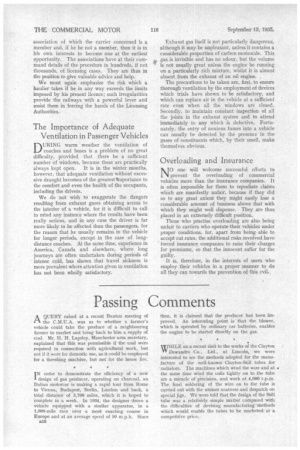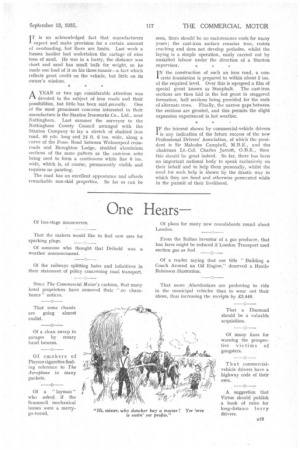Passing Comments
Page 28

Page 29

If you've noticed an error in this article please click here to report it so we can fix it.
AQUERY raised at a recent Buxton meeting of the C.M.U.A. was as to whether a farmer's vehicle could take the produce of a neighbouring farmer to market and bring back to him a supply of coal. Mr. H. H. Lapsley, Manchester area secretary, explained that this was permissible if the coal were required in connection with agricultural work, but not if it were for domestic use, as it could be employed for a threshing machine, but not for the house fire.
I N order to demonstrate the efficiency of a new design of gas producer, operating on charcoal, an Italian motorcar is making a rapid tour from Rome to Vienna, Budapest, Berlin, London and back, a total distance of 3,700 miles, which it is hoped to comPlete in a week. In 1934, the designer drove a Vehicle equipped with a similar apparatus, in a 1,000-mile race over a most exacting -course in Europe and at an average speed of 50 m.p.h. Since B1.8 then, it is claimed that the producer has been improved. An interesting point is that the blower, which is operated by ordinary car batteries, enables the engine th be started directly on the gas.
WHILE on a recent visit to the works of the Clayton " Dewandre Co., Ltd., at Lincoln, we were interested to see the methods adopted for the mann„facture of the well-known Clayton-Still tubes for 'radiators. The machines which wind the wire and at • the same time wind the coils tightly on to the tube are a miracle of Precision, and work at 4,000 r.p_m. The final soldering of the wire on to the tube is carried out with the utmost neatness and despatch on special jigs. We were told that the design of the Still tube was a relatively simple matter compared with the difficulties of devising manufacturing methods which would enable the tubes to be marketed at .a competitive price.
TT is an acknowledged fact that manufacturers I expect and make provision for a certain amount of overloading, but there are limits. Last week a Sussex haulier had undertaken the cartage of nine tons of sand. He was in a hurry, the distance was short and sand has small bulk for weight, so he made one load of it on his three-tonner—a fact which reflects great credit on the vehicle, but little on its owner's wisdom.
A YEAR or two ago considerable attention was A-I devoted to the subject of iron roads and their possibilities, but little has been said secently. One of the most prominent concerns interested in their manufacture is the Stanton Ironworks Co., Ltd., near Nottingham. Last summer the surveyor to the Nottingham County Council arranged with the Stanton Company to lay a stretch of studded iron road, 40 yds. long and 24 ft. 6 ins, wide, along a curve of the Fosse Road between Widmerpool crossroads and Broughton Lodge, studded aluminipm sections of the same pattern as the cast-iron setts being used to form a continuous white line 6 ins. wide, which is, of course, permanently visible and requires no painting.
The road has an excellent appearance and affords remarkable non-skid properties. So far as can be seen, there should be no maintenance costs for many years ; the cast-iron surface remains true, resists cracking and does not develop potholes, whilst the laying is a simple operation, easily carried out by unskilled labour under the direction of a Stanton supervisor. * IN the construction of such an iron road, a con crete foundation is prepared to within about 2 ins. of the required level. Over this is sqeegeed a film of special grout known as Stanphalt. The cast-iron sections are then laid in the hot grout in staggered fonnation, half sections being provided for the ends of alternate rows. Finally, the narrow gaps between the sections are grouted, and this permits the slight expansion experienced in hot weather.
I F the interest shown by commercial-vehicle drivers is any indication of the future success of the new Professional Drivers' Association, of which the president is Sir Malcolm Campbell, M.B.E., and the chairman Lt.-Col. Charles Jarroft, O.B.E., then this should be great indeed. So far, there has been no important national body to speak exclusively on their behalf and to help them personally, whilst the need for such help is shown by the drastic way in which they are fined and otherwise persecuted while in the pursuit of their livelihood.




















































































